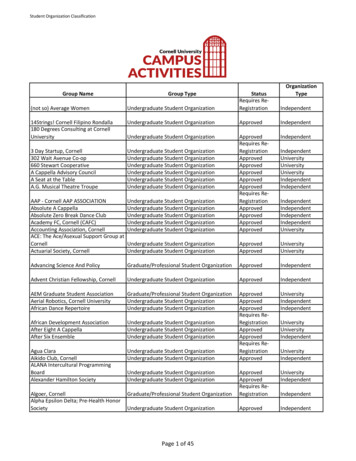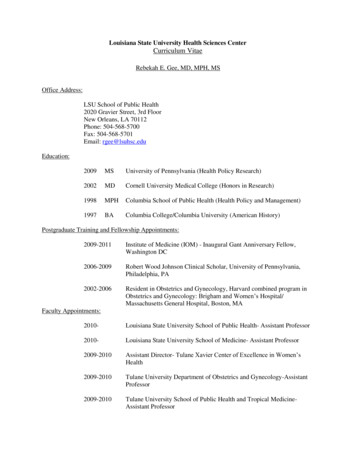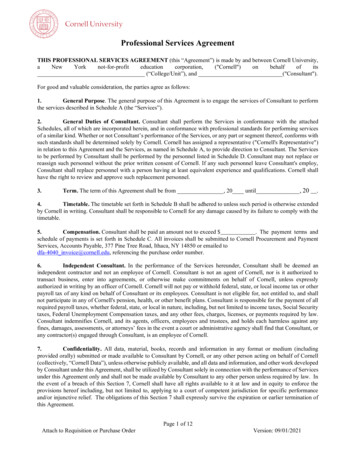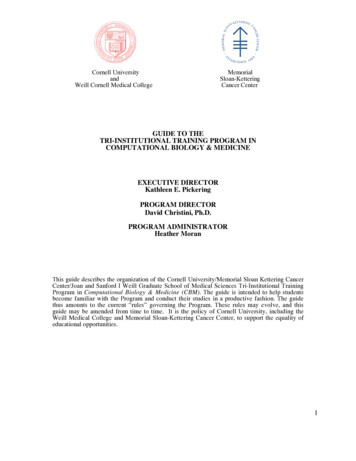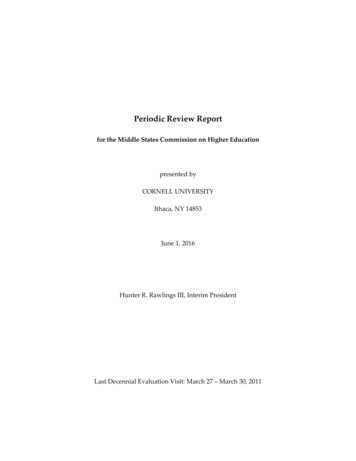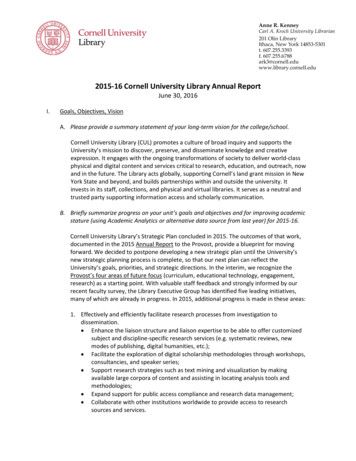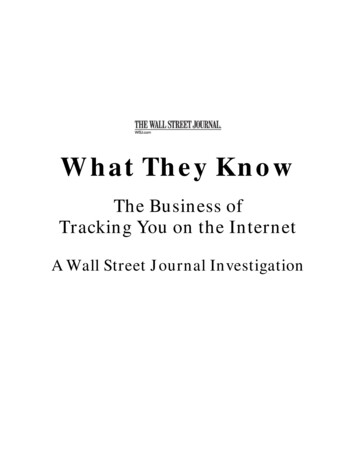
Transcription
What They KnowThe Business ofTracking You on the InternetA Wall Street Journal Investigation
2Table of ContentsIntroduction . 3Contributors . 6The Web's New Gold Mine: Your Secrets . 7Explore the Data . 14Sites Feed Personal Details To New Tracking Industry . 15How to Avoid the Prying Eyes . 17What They Know About You . 20Microsoft Quashed Effort To Boost Online Privacy . 22On the Web's Cutting Edge, Anonymity in Name Only .27Stalking by Cellphone. 33Google Agonizes on Privacy as Ad World Vaults Ahead . 39On the Web, Children Face Intensive Tracking . 45Explore the Data . 50How to Protect Your Child’s Privacy Online . 51'Scrapers' Dig Deep For Data on Web .53Facebook in Privacy Breach . 58A Web Pioneer Profiles Users by Name . 62Politicians Tap Sophisticated Online Tracking Tools . 68Insurers Test Data Profiles To Identify Risky Clients . 70Inside Deloitte's Life-Insurance Assessment Technology . 75Shunned Profiling Method On the Verge of Comeback .76Race Is On To ‘Fingerprint’ Phones, PCs. 81How To Prevent Device Fingerprinting . 86Your Apps Are Watching You . 88Explore the Data . 94What Can You Do? Not Much . 95What Settings to Look For in Apps . 96Methodology . 98Tracking the Trackers: Our Method . 99How the Analysis of Children's Websites Was Conducted . 101The Journal's Cellphone Testing Methodology .103Glossary .104THE WALL STREET JOURNAL is a trademark of Dow Jones. 2010 by Dow Jones & Company, Inc. All rights reserved
3IntroductionWhat do they know about me?Who hasn't wondered that after receiving a spookily correct mortgage offerfor the exact balance of your debt? Or when an ad appears on your computerscreen for something you were just thinking about but hadn't typed yet?Our modern life is filled with these minor but eerie intrusions – whetherthey arrive in snail mail, the e-mail inbox, or pop up as we browse the Web.Marketers are indeed watching us and compiling dossiers about us all the time.But until recently, there wasn't an easy way to find out what they knew about us.Until the Internet came along, the information that companies had about uswas stored in dusty files and used primarily by the folks filling our mailboxes withjunk mail. Gathering information about people was expensive and difficult: databrokers had to gather people's real estate records, motor vehicle records andkeep up with Americans’ propensity to move every few years.The Internet made monitoring people much easier. Suddenly companiescould embed a tiny piece of code in a website and see anything that a personwas doing on a web page. As people spent more time online, more of their lifecould be monitored.By 2010, online tracking had become a fundamental part of the 23 billiononline advertising economy. Hundreds of companies popped up to offer newways to track users online. Trading floors emerged to allow our digital records tobe bought and sold in an instant. And the beauty of these digital files was thatoccasionally they could be decoded – revealing a dossier for the first time.Most people surfing the Web had no idea of the scope and intrusiveness ofthis new industry that was watching their every move.So The Wall Street Journal sought to decode these new trackingtechnologies, allowing readers for the first time to glimpse behind the curtain ofthe personal data-gathering industry.It wasn’t an easy task. The Journal reporters learned how to "sniff on thewire" – or decode computer talk – to identify tracking tools on the 100 of the mostpopular kids and adult websites. The Journal hired technologists to set up aTHE WALL STREET JOURNAL is a trademark of Dow Jones. 2010 by Dow Jones & Company, Inc. All rights reserved
4mobile lab in Denver to test "apps" in a secure environment – disabling thephones' cellular service and forcing traffic through Wi-Fi where it could becollected and analyzed in a groundbreaking study. Journal reporters crackedcomputer code to reveal a significant Facebook privacy breach, and how CapitalOne was using tracking data to estimate the incomes and lifestyles of visitors toits website.The series launched on July 31, 2010, with an online database of all thetracking tools the Journal had found in its visits to the top 50 U.S. websites. Itsfindings included: 234 tracking devices on Dictionary.com alone; companiesestimating income and diseases of users; and a company tracking people'sfavorite movies as they typed them into a website.The Journal's reporting shocked even the technology elite, many of whomhadn't realized how sophisticated the tracking industry had become. "It’s prettyfreaking amazing — and amazingly freaky," Doc Searls, a fellow at HarvardUniversity's Berkman Center for Internet and Society, wrote on his blog the daythe series launched. "The tide has turned today."The tide continued to turn throughout the year, as the Journal revealedmore disturbing facts about the commercial data-gathering industry. It caughtred-handed a company breaking Facebook's rules to obtain user names for sale.It nabbed Nielsen Co. breaking into a medical website to "scrape" patient dataand sell it.It revealed companies using undetectable tracking techniques, such as"deep packet inspection" and "device fingerprinting." It found that advertisershad influenced Microsoft's decision to remove privacy features from its Webbrowser.It found that children's websites were more heavily monitored than adults’.It found that iPhone and Android "apps" were secretly sending out data aboutusers to tracking companies. And the Journal found that tracking data was beingused by life insurers and credit card issuers to help make financial decisionsabout customers.In short, the Journal unveiled a massive surveillance industry usingsophisticated tools to secretly monitor users’ behavior – and to use thatinformation to make important decisions about people's lives.The impact of the series was profound. Driven by swelling public concernabout tracking, the Obama administration reversed the government's decadelong hands-off approach to Internet privacy regulation and called for an Internet"privacy bill of rights." The Federal Trade Commission, which had previouslysupported the industry's self-regulatory efforts, declared in December that selfregulation had failed and called for a do-not-track tool to be installed in Webbrowsing software.Companies also began changing their privacy practices in response to theJournal's reporting. Facebook banned the data collection company RapLeaf Inc.THE WALL STREET JOURNAL is a trademark of Dow Jones. 2010 by Dow Jones & Company, Inc. All rights reserved
5from its website after the Journal revealed that RapLeaf was taking userinformation and transmitting it to tracking companies. After the Journal's article,Nielsen said it would no longer create fake usernames and passwords to log intoprivate message boards to scrape data.In December, Microsoft Corp. reversed its decision to remove privacy toolsfrom its Web browser. It will add a powerful privacy feature similar to the one itdropped from an earlier version back into Internet Explorer 9 when it launches in2011. Mozilla Corp. soon followed by announcing it would add a do-not-tracktool to the Firefox Web browser. And Google said it would improve an antitracking tool it offered.And the debate about tracking is only beginning. Online tracking tools aregetting ever more sophisticated. Ultimately, we will need to decide how muchsurveillance we as a society are willing to accept.JULIA ANGWINSenior technology editor, WSJ.comTHE WALL STREET JOURNAL is a trademark of Dow Jones. 2010 by Dow Jones & Company, Inc. All rights reserved
6ContributorsReportersJulia Angwin, Geoffrey Fowler, Yukari Iwatani Kane, Mark Maremont,Justin Scheck, Leslie Scism, Paul Sonne, Steve Stecklow, Emily Steel, ScottThurm, Jennifer Valentino-DeVries, Jessica Vascellaro, Nick WingfieldEditorsJesse Pesta, Julia Angwin, Scott Thurm, Steve Yoder, Mitch PacelleResearch and data analysisTom McGinty, Julia Angwin, Courtney Banks, Marisa Taylor, Scott Thurm,Jennifer Valentino-DeVriesPrint and interactive graphicsPaul Antonson, Andrew Garcia-Phillips, Mei Lan Ho-Walker, Jovi Juan,Jonathan Keegan, Susan McGregor, Andrew Robinson, Sarah Slobin, KurtWilberdingTechnology consultantsDavid Campbell, Ashkan SoltaniTHE WALL STREET JOURNAL is a trademark of Dow Jones. 2010 by Dow Jones & Company, Inc. All rights reserved
7The Web's New Gold Mine:Your SecretsBY JULIA ANGWINHidden inside Ashley Hayes-Beaty's computer, a tiny file helps gatherpersonal details about her, all to be put up for sale for a tenth of a penny.The file consists of a single code—4c812db292272995e5416a323e79bd37—that secretly identifies her as a 26-year-old female in Nashville, Tenn.The code knows that her favorite movies include "The Princess Bride," "50First Dates" and "10 Things I Hate About You." It knows she enjoys the "Sex andthe City" series. It knows she browses entertainment news and likes to takequizzes."Well, I like to think I have some mystery left to me, but apparently not!"Ms. Hayes-Beaty said when told what that snippet of code reveals about her."The profile is eerily correct."Ms. Hayes-Beaty is being monitored by Lotame Solutions Inc., a New Yorkcompany that uses sophisticated software called a "beacon" to capture whatpeople are typing on a website—their comments on movies, say, or their interestin parenting and pregnancy. Lotame packages that data into profiles aboutindividuals, without determining a person's name, and sells the profiles tocompanies seeking customers. Ms. Hayes-Beaty's tastes can be sold wholesale(a batch of movie lovers is 1 per thousand) or customized (26-year-old Southernfans of "50 First Dates")."We can segment it all the way down to one person," says Eric Porres,Lotame's chief marketing officer.One of the fastest-growing businesses on the Internet, a Wall StreetJournal investigation has found, is the business of spying on Internet users.The Journal conducted a comprehensive study that assesses andanalyzes the broad array of cookies and other surveillance technology thatcompanies are deploying on Internet users. It reveals that the tracking ofconsumers has grown both far more pervasive and far more intrusive than isrealized by all but a handful of people in the vanguard of the industry. The study found that the nation's 50 top websites on averageinstalled 64 pieces of tracking technology onto the computers ofTHE WALL STREET JOURNAL is a trademark of Dow Jones. 2010 by Dow Jones & Company, Inc. All rights reserved
8visitors, usually with no warning. A dozen sites each installed morethan a hundred. The nonprofit Wikipedia installed none. Tracking technology is getting smarter and more intrusive.Monitoring used to be limited mainly to "cookie" files that recordwebsites people visit. But the Journal found new tools that scan inreal time what people are doing on a Web page, then instantlyassess location, income, shopping interests and even medicalconditions. Some tools surreptitiously re-spawn themselves evenafter users try to delete them. These profiles of individuals, constantly refreshed, are bought andsold on stock-market-like exchanges that have sprung up in the past18 months.The new technologies are transforming the Internet economy. Advertisersonce primarily bought ads on specific Web pages—a car ad on a car site. Now,advertisers are paying a premium to follow people around the Internet, whereverthey go, with highly specific marketing messages.In between the Internet user and the advertiser, the Journal identified morethan 100 middlemen—tracking companies, data brokers and advertisingnetworks—competing to meet the growing demand for data on individualbehavior and interests.The data on Ms. Hayes-Beaty's film-watching habits, for instance, is beingoffered to advertisers on BlueKai Inc., one of the new data exchanges."It is a sea change in the way the industry works," says Omar Tawakol,CEO of BlueKai. "Advertisers want to buy access to people, not Web pages."The Journal examined the 50 most popular U.S. websites, which accountfor about 40% of the Web pages viewed by Americans. (The Journal also testedits own site, WSJ.com.) It then analyzed the tracking files and programs thesesites downloaded onto a test computer.As a group, the top 50 sites placed 3,180 tracking files in total on theJournal's test computer. Nearly a third of these were innocuous, deployed toremember the password to a favorite site or tally most-popular articles.But over two-thirds—2,224—were installed by 131 companies, many ofwhich are in the business of tracking Web users to create rich databases ofconsumer profiles that can be sold.The top venue for such technology, the Journal found, was IAC/InterActiveCorp.'s Dictionary.com. A visit to the online dictionary site resulted in 234 files orprograms being downloaded onto the Journal's test computer, 223 of which werefrom companies that track Web users.The information that companies gather is anonymous, in the sense thatInternet users are identified by a number assigned to their computer, not by aspecific person's name. Lotame, for instance, says it doesn't know the name ofusers such as Ms. Hayes-Beaty—only their behavior and attributes, identified byTHE WALL STREET JOURNAL is a trademark of Dow Jones. 2010 by Dow Jones & Company, Inc. All rights reserved
9code number. People who don't want to be tracked can remove themselves fromLotame's system.And the industry says the data are used harmlessly. David Moore,chairman of 24/7 RealMedia Inc., an ad network owned by WPP PLC, saystracking gives Internet users better advertising."When an ad is targeted properly, it ceases to be an ad, it becomesimportant information," he says.Tracking isn't new. But the technology is growing so powerful andubiquitous that even some of America's biggest sites say they were unaware,until informed by the Journal, that they were installing intrusive files on visitors'computers.The Journal found that Microsoft Corp.'s popular Web portal, MSN.com,planted a tracking file packed with data: It had a prediction of a surfer's age, ZIPCode and gender, plus a code containing estimates of income, marital status,presence of children and home ownership, according to the tracking companythat created the file, Targus Information Corp.Both Targus and Microsoft said they didn't know how the file got ontoMSN.com, and added that the tool didn't contain "personally identifiable"information.Tracking is done by tiny files and programs known as "cookies," "Flashcookies" and "beacons." They are placed on a computer when a user visits awebsite. U.S. courts have ruled that it is legal to deploy the simplest type,cookies, just as someone using a telephone might allow a friend to listen in on aconversation. Courts haven't ruled on the more complex trackers.The most intrusive monitoring comes from what are known in the businessas "third party" tracking files. They work like this: The first time a site is visited, itinstalls a tracking file, which assigns the computer a unique ID number. Later,when the user visits another site affiliated with the same tracking company, it cantake note of where that user was before, and where he is now. This way, overtime the company can build a robust profile.One such ecosystem is Yahoo Inc.'s ad network, which collects fees byplacing targeted advertisements on websites. Yahoo's network knows manythings about recent high-school graduate Cate Reid. One is that she is a 13- to18-year-old female interested in weight loss. Ms. Reid was able to determine thiswhen a reporter showed her a little-known feature on Yahoo's website, the AdInterest Manager, that displays some of the information Yahoo had collectedabout her.Yahoo's take on Ms. Reid, who was 17 years old at the time, hit the mark:She was, in fact, worried that she may be 15 pounds too heavy for her 5-foot, 6inch frame. She says she often does online research about weight loss."Every time I go on the Internet," she says, she sees weight-loss ads. "I'mself-conscious about my weight," says Ms. Reid, whose father asked that herTHE WALL STREET JOURNAL is a trademark of Dow Jones. 2010 by Dow Jones & Company, Inc. All rights reserved
10hometown not be given. "I try not to think about it . Then [the ads] make mestart thinking about it."Yahoo spokeswoman Amber Allman says Yahoo doesn't knowingly targetweight-loss ads at people under 18, though it does target adults."It's likely this user received an untargeted ad," Ms. Allman says. It's alsopossible Ms. Reid saw ads targeted at her by other tracking companies.Information about people's moment-to-moment thoughts and actions, asrevealed by their online activity, can change hands quickly. Within seconds ofvisiting eBay.com or Expedia.com, information detailing a Web surfer's activitythere is likely to be auctioned on the data exchange run by BlueKai, the Seattlestartup.Each day, BlueKai sells 50 million pieces of information like this aboutspecific individuals' browsing habits, for as little as a tenth of a cent apiece. Theauctions can happen instantly, as a website is visited.Spokespeople for eBay Inc. and Expedia Inc. both say the profiles BlueKaisells are anonymous and the people aren't identified as visitors of their sites.BlueKai says its own website gives consumers an easy way to see what itmonitors about them.Tracking files get onto websites, and downloaded to a computer, in severalways. Often, companies simply pay sites to distribute their tracking files.But tracking companies sometimes hide their files within free softwareoffered to websites, or hide them within other tracking files or ads. When thishappens, websites aren't always aware that they're installing the files on visitors'computers.Often staffed by "quants," or math gurus with expertise in quantitativeanalysis, some tracking companies use probability algorithms to try to pair whatthey know about a person's online behavior with data from offline sources abouthousehold income, geography and education, among other things.The goal is to make sophisticated assumptions in real time—plans for asummer vacation, the likelihood of repaying a loan—and sell those conclusions.Some financial companies are starting to use this formula to show entirelydifferent pages to visitors, based on assumptions about their income andeducation levels.Life-insurance site AccuquoteLife.com, a unit of Byron Udell & AssociatesInc., in June 2010 tested a system showing visitors it determined to be suburban,college-educated baby-boomers a default policy of 2 million to 3 million, saysAccuquote executive Sean Cheyney. A rural, working-class senior citizen mightsee a default policy for 250,000, he says."We're driving people down different lanes of the highway," Mr. Cheyneysays.Consumer tracking is the foundation of an online advertising economy thatracked up 23 billion in ad spending in 2009. Tracking activity is exploding.THE WALL STREET JOURNAL is a trademark of Dow Jones. 2010 by Dow Jones & Company, Inc. All rights reserved
11Researchers at AT&T Labs and Worcester Polytechnic Institute last fall foundtracking technology on 80% of 1,000 popular sites, up from 40% of those sites in2005.The Journal found tracking files that collect sensitive health and financialdata. On Encyclopedia Britannica Inc.'s dictionary website MerriamWebster.com, one tracking file from Healthline Networks Inc., an ad network,scans the page a user is viewing and targets ads related to what it sees there.So, for example, a person looking up depression-related words could seeHealthline ads for depression treatments on that page—and on subsequentpages viewed on other sites.Healthline says it doesn't let advertisers track users around the Internetwho have viewed sensitive topics such as HIV/AIDS, sexually transmitteddiseases, eating disorders and impotence. The company does let advertiserstrack people with bipolar disorder, overactive bladder and anxiety, according toits marketing materials.Targeted ads can get personal. In 2009, Julia Preston, a 32-year-oldeducation-software designer in Austin, Texas, researched uterine disordersonline. Soon after, she started noticing fertility ads on sites she visited. She nowknows she doesn't have a disorder, but still gets the ads.It's "unnerving," she says.Tracking became possible in 1994 when the tiny text files called cookieswere introduced in an early browser, Netscape Navigator. Their purpose wasuser convenience: remembering contents of Web shopping carts.Back then, online advertising barely existed. The first banner ad appearedthe same year. When online ads got rolling during the dot-com boom of the late1990s, advertisers were buying ads based on proximity to content—shoe ads onfashion sites.The dot-com bust triggered a power shift in online advertising, away fromwebsites and toward advertisers. Advertisers began paying for ads only ifsomeone clicked on them. Sites and ad networks began using cookiesaggressively in hopes of showing ads to people most likely to click on them, thusgetting paid.Targeted ads command a premium. In 2009, the average cost of atargeted ad was 4.12 per thousand viewers, compared with 1.98 per thousandviewers for an untargeted ad, according to an ad-industry-sponsored study inMarch 2010.The Journal examined three kinds of tracking technology—basic cookiesas well as more powerful "Flash cookies" and bits of software code called"beacons."More than half of the sites examined by the Journal installed 23 or more"third party" cookies. Dictionary.com installed the most, placing 159 third-partycookies.THE WALL STREET JOURNAL is a trademark of Dow Jones. 2010 by Dow Jones & Company, Inc. All rights reserved
12Cookies are typically used by tracking companies to build lists of pagesvisited from a specific computer. A newer type of technology, beacons, canwatch even more activity.Beacons, also known as "Web bugs" and "pixels," are small pieces ofsoftware that run on a Web page. They can track what a user is doing on thepage, including what is being typed or where the mouse is moving.The majority of sites examined by the Journal placed at least sevenbeacons from outside companies. Dictionary.com had the most, 41, includingseveral from companies that track health conditions and one that says it cantarget consumers by dozens of factors, including zip code and race.Dictionary.com President Shravan Goli attributed the presence of so manytracking tools to the fact that the site was working with a large number of adnetworks, each of which places its own cookies and beacons. After the Journalcontacted the company, it cut the number of networks it uses and beefed up itsprivacy policy to more fully disclose its practices.The widespread use of Adobe Systems Inc.'s Flash software to play videosonline offers another opportunity to track people. Flash cookies originally weremeant to remember users' preferences, such as volume settings for onlinevideos.But Flash cookies can also be used by data collectors to re-install regularcookies that a user has deleted. This can circumvent a user's attempt to avoidbeing tracked online. Adobe condemns the practice.Most sites examined by the Journal installed no Flash cookies.Comcast.net installed 55.That finding surprised the company, which said it was unaware of them.Comcast Corp. subsequently determined that it had used a piece of free softwarefrom a company called Clearspring Technologies Inc. to display a slideshow ofcelebrity photos on Comcast.net. The Flash cookies were installed on Comcast'ssite by that slideshow, according to Comcast.Clearspring, based in McLean, Va., says the 55 Flash cookies were amistake. The company says it no longer uses Flash cookies for tracking.CEO Hooman Radfar says Clearspring provides software and services towebsites at no charge. In exchange, Clearspring collects data on consumers. Itplans eventually to sell the data it collects to advertisers, he says, so that siteusers can be shown "ads that don't suck." Comcast's data won't be used,Clearspring says.Wittingly or not, people pay a price in reduced privacy for the informationand services they receive online. Dictionary.com, the site with the most trackingfiles, is a case study.The site's annual revenue, about 9 million in 2009 according to an SECfiling, means the site is too small to support an extensive ad-sales team. So itTHE WALL STREET JOURNAL is a trademark of Dow Jones. 2010 by Dow Jones & Company, Inc. All rights reserved
13needs to rely on the national ad-placing networks, whose business model is builton tracking.Dictionary.com executives say the trade-off is fair for their users, who getfree access to its dictionary and thesaurus service."Whether it's one or 10 cookies, it doesn't have any impact on thecustomer experience, and we disclose we do it," says Dictionary.com spokesmanNicholas Graham. "So what's the beef?"The problem, say some industry veterans, is that so much consumer datais now up for sale, and there are no legal limits on how that data can be used.Until recently, targeting consumers by health or financial status wasconsidered off-limits by many large Internet ad companies. Now, some aim totake targeting to a new level by tapping online social networks.Media6Degrees Inc., whose technology was found on three sites by theJournal, is pitching banks to use its data to size up consumers based on theirsocial connections. The idea is that the creditworthy tend to hang out with thecreditworthy, and deadbeats with deadbeats."There are applications of this technology that can be very powerful," saysTom Phillips, CEO of Media6Degrees. "Who knows how far we'd take it?"Emily Steel, Jennifer Valentino-DeVries and Tom McGinty contributed tothis report.Published July 30, 2010.THE WALL STREET JOURNAL is a trademark of Dow Jones. 2010 by Dow Jones & Company, Inc. All rights reserved
14Explore the Datahttp://blogs.wsj.com/wtk/THE WALL STREET JOURNAL is a trademark of Dow Jones. 2010 by Dow Jones & Company, Inc. All rights reserved
15Sites Feed Personal DetailsTo New Tracking IndustryBY JULIA ANGWIN and TOM MCGINTYThe largest U.S. websites are installing new and intrusive consumertracking technologies on the computers of people visiting their sites—in somecases, more than 100 tracking tools at a time—a Wall Street Journalinvestigation has found.The tracking files represent the leading edge of a lightly regulated,emerging industry of data-gatherers who are in effect establishing a newbusiness model for the Internet: one based on intensive surveillance of people tosell data about, and predictions of, their interests and activities, in real time.The Journal's study shows the extent to which Web users are in effectexchanging personal data for the broad access to information and services that isa defining feature of the Internet.In an effort to quantify the reach and sophistication of the tracking industry,the Journal examined the 50 most popular websites in the U.S. to measure thequantity and capabilities of the "cookies," "beacons" and other trackers installedon a visitor's computer by each site. Together, the 50 sites account for roughly40% of U.S. page-views.The 50 sites installed a total of 3,180 tracking files on a test computer usedto conduct the study. Only one site, the encyclopedia Wikipedia.org, installednone. Twelve sites, including IAC/InterActive Corp.'s Dictionary.com, ComcastCorp.'s Comcast.net and Microsoft Corp.'s MSN.com, installed more than 100tracking tools apiece in the course of the Journal's test.The Journal also surveyed its own site, WSJ.com, which doesn't rankamong the top 50 by visitors. WSJ.com installed 60 tracking files, slightly belowthe 64 average for the top 50 sites.Some two-thirds of the tracking tools installed—2,224—came from 131companies that, for the most part, are in the business of following Internet usersto create rich databases of consumer profiles that can be sold. The companiesthat placed the most such tools were Google Inc., Microsoft Corp and QuantcastCorp., all of which are in the business of targeting ads at people online.THE WALL STREET JOURNAL is a trademark of Dow Jones.
sold on stock-market -like exchanges that have sprung up in the past 18 months. The new technologies are transforming the Internet economy. Advertisers once primarily bought ads on specific Web pages—a car ad on a car site. Now, advertisers are paying a premium to follow people around the Internet, wherever

